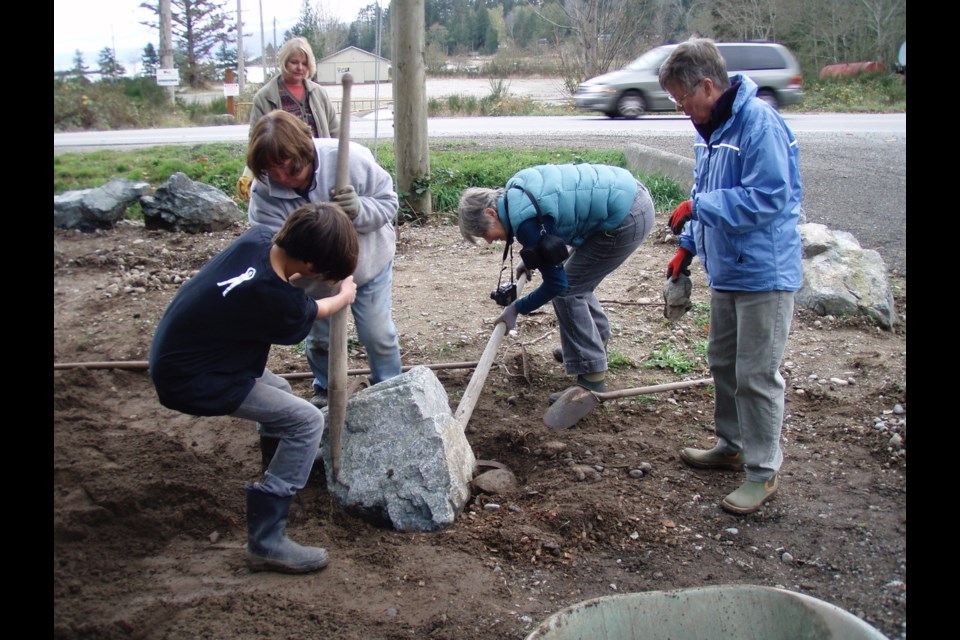For more than a decade, Lang Creek Native Plant Garden has existed in conjunction with the work of Powell River Salmon Society (PRSS).
The garden was created at the mouth of the Lang Creek spawning channel on two acres owned by PRSS. The site became an ongoing work in progress by volunteers and was transformed over time into a kind of sanctuary with benches for sitting, art work, pathways and educational signs. People can learn about native plant species and their importance to the health of the ecosystem, including salmon that use the creek.
That's why the garden steering committee/volunteers said they were in shock upon receiving notice, on January 30, that PRSS would be removing most of the native plant garden in order to extend the parking lot at Alex Dobler Salmon Centre.
PRSS directors cited safety with the unloading of school buses during the annual week-long salmon exposition each fall as the reason for the expansion, the garden group stated in an email to the Peak: "Needless to say, we are shocked and heart-broken at hearing this news. Our immediate goal is to encourage the PRSS board to reconsider their decision and to look for creative alternatives to the parking safety issues," the email stated.
The Peak reached out to Lang Creek Native Plant Garden (LCNPG) steering committee members Gail Scholefield, Joyce Bredo, Lena and Laura Johnson, Elizabeth Kennedy, Sharon Shultz, Michael Stewart and Wendy Cocksedge, with some questions about the group's predicament.
Peak: Why did you choose this location for the garden?
LCNPG: “PRSS determined the location and footprint of the garden and hired professionals to develop a plan. Volunteers provided the gardening labour and later developed a steering committee to ensure ongoing maintenance and care.”
Peak: What was the initial vision for the space?
LCNPG: “The PRSS board envisioned a garden that would welcome visitors. The volunteers, many of whom were educators, enhanced this vision to showcase the beauty and biodiversity of our native plants that support salmon enhancement. We envisioned a botanical learning centre, or green classroom to complement the work of the PRSS.”
Peak: What type of work do volunteers do at the garden, and how many volunteers are there?
LCNPG: “We have 83 registered volunteers who maintain the gardens, fundraise to cover garden expenses and care for the garden benches and signs. Volunteers have also developed educational materials for the use of students, teachers and visitors.”
Peak: How will the removal of the garden impact the school community?
LCNPG: “The removal of the garden will create a loss of rich learning experiences for students of all ages. There is something for everyone at a glance, with an exposure to lots of different native plants in a small space. Educational signs are posted throughout the garden. Those signs cover botanical information and how First Nations used these plants.”
Peak: What will the impact be on garden volunteers?
LCNPG: “Garden volunteers are devastated, deeply saddened, and confused that we were not consulted or asked to participate in the decision-making process. We feel there can be a workable solution that saves the garden.”
Peak: Will the entire garden be removed?
LCNPG: “We hope not. It appears that the planned parking lot expansion will decimate the majority of the garden.”
Peak: Why is this native plant garden important to members of the Lang Creek community and the greater qathet community?
LCNPG: “Comments which we have received as we lobby to save the garden have made it clear to us that this is a valuable asset to the qathet community. The native plant garden has become a popular destination for artists and birdwatchers.
Our goal is to explore every avenue in order to save the garden. We have been long-term supporters of salmon and will continue to be. We know that the native garden is a vital part of the salmon ecosystem.”
According to the National Oceanic and Atmospheric Administration, native plants provide much-needed food and shelter for native insects, some of which salmon eat during their early life cycle stages.
Lang Creek Native Plant Garden members said they are also concerned about damage to the riparian area of the spawning channel.
“The native plants in our garden provide filtration of toxins.”
The Peak has reached to PRSS for comment, but has not heard back yet.
Join the Peak’s email list for the top headlines right in your inbox Monday to Friday.




